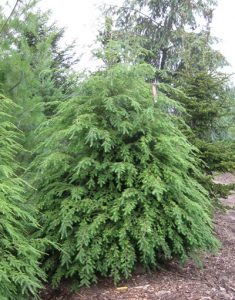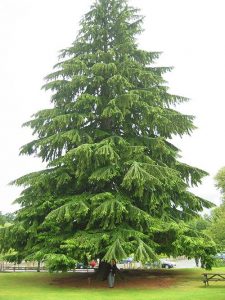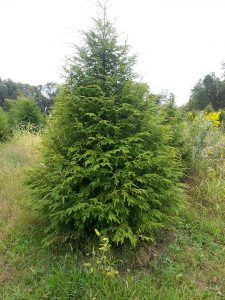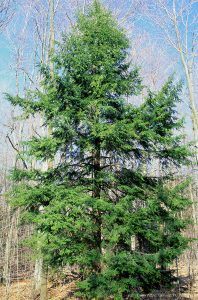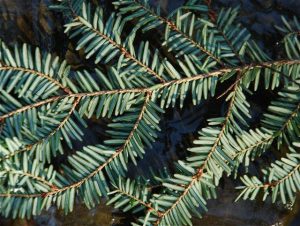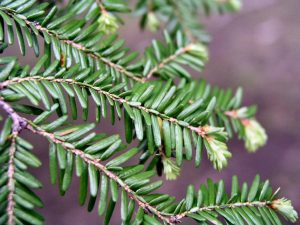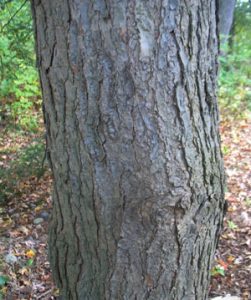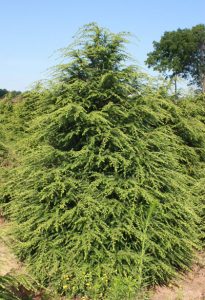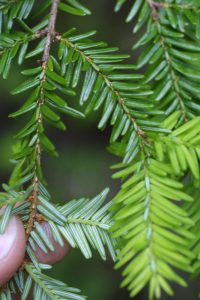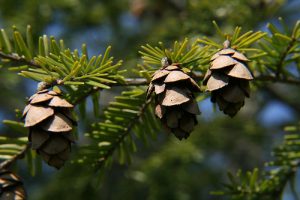Eastern Hemlock (Canadian Hemlock)
The Eastern Hemlock stands as a living testament to nature’s endurance. With its graceful, soft needles and towering height, this majestic evergreen tree dominates forests across eastern North America. Known for its resilience, ecological importance, and cultural significance, the Eastern Hemlock continues to inspire awe, while providing shelter, food, and environmental balance in the ecosystems it inhabits.
The Majestic Eastern Hemlock
The Eastern Hemlock, also known as the Canadian Hemlock, is one of the most significant trees in North America. Found in the temperate forests of northeastern United States and parts of Canada, this towering evergreen can grow up to 100 feet tall. Its distinctive, fine needles and delicate cones make it easily recognizable. It’s not just an ecological marvel; it has been crucial to human industries and cultures throughout history, from its valuable timber to its medicinal uses.
Eastern hemlock is a species of conifers found across eastern North America at elevations of 600-1800 meters (2,000-5,900 feet).
Scientific Classification
| Kingdom: | Plantae |
| Division: | Pinophyta |
| Class: | Pinopsida |
| Order: | Pinales |
| Family: | Pinaceae |
| Genus: | Tsuga |
| Scientific Name: | Tsuga canadensis |
Physical Characteristics: A Towering Presence with Unique Foliage
The Eastern Hemlock is a majestic conifer that reaches impressive heights of up to 100 feet, with some exceptional specimens growing as tall as 174 feet. Its dark green, flat needles grow in a unique arrangement, and they measure 15-20 mm in length. The tree’s cones are small, ovoid, and light brown, ranging from 1.5-2.5 cm in length. The bark is thin, reddish-brown, and furrowed, offering protection from cold weather and pests. With its large, straight trunk and upward-reaching branches, the Eastern Hemlock has a striking appearance, which is enhanced by its slender, graceful form.
Key Features:
- Height: Up to 100 feet, with some reaching 174 feet
- Needles: Evergreen, flat, 15-20 mm in length
- Cones: Small, ovoid, 1.5-2.5 cm long
- Bark: Thin, reddish-brown, and furrowed
These features not only give the Eastern Hemlock its iconic appearance but also make it a vital contributor to the forests it inhabits.
Quick Information
| Other Names | Canadian hemlock, hemlock spruce |
| Size | 31 meters(102 feet); exceptional specimens have been known to grow up to 53 meters(174 feet); straight and monopodial trunks. |
| Leaves (Needles) | Evergreen; flattened and typically distichous; 15 to 20 mm(0.59 to 0.79 inches) in length, could be as short as 5 mm(0.20 in) or as long as 25 mm(0.98 in). |
| Cones (Strobili) | Ovoid; 1.5-2.5cm (0.59-0.98 in) in length, 1-1.5 cm (0.39-0.59in) in width |
| Tree Type | Needled evergreen |
| Branches | Lower branches gravitate towards the ground |
| Shape | Slightly rounded apex, projecting outward |
| Distribution/Range | Ranges from NE Minnesota to Southern Quebec and Nova Scotia, and south in the Appalachian Mountains to Northern Georgia and Alabama. |
| Hardiness Zones | 3 to 7 |
| Lifespan | 250-300 years to reach maturity; may live for 800 years or more |
| Growth Rate | Medium |
| Growing Conditions | Winter Conditions: Grows in cool, humid conditions; winter temperatures average about 10°-42° F (-12°-6° C)Summer Conditions: Temperatures average about 60° F (16° C) Rainfall: Areas where annual precipitation ranges between 740 mm and 1520 mm Sunlight: Partial sun/partial shade Soil Requirements: Sandy, loamy, moist, well-drained, acidic |
| Problems | Pest insects such as hemlock wooly adelgid; root rot disease |
| Flowering/Fruiting | Male flowers are yellow, small and round; females light green at branch tips;Fruits are ovoid, light brown cone, 3-4 inch long with rounded scales, maturing in early fall |
| Seed production | During mid-spring female flowers turn into green cones, once these cones turn brown and start to open slightly, seeds are ready to be picked |
| Seedling development | Seeds germinate when the temperature is around 15° C (59° F) |
| Wildlife Value | Black-throated blue warbler, black-throated green warbler, Blackburnian warbler are abundant in eastern hemlock cove forests; the white-tailed deer feed on the hardwood sprouts, foliage, and seedlings |
| Cultivars | More than 300 cultivars including some dwarf forms and weeping shrubs are used; popular varieties are:‘Beehive’ ‘Bennett’ ‘Cole’s Prostrate’ ‘Gentsch White’ ‘Pendula’ ‘Jeddeloh’ ‘Sargentii’ |
| Uses | Lumber is used for crates, general construction, railroad ties; also for pulp and papermaking; the Canadian hemlock makes for a durable and thick hedge |
| Identification of wood | Soft, coarse-grained and light buff in color |
| IUCN Conservation Status | Near Threatened |
Ecological Importance: Vital to Forest Health and Wildlife
The Eastern Hemlock plays an essential role in its ecosystem. Its dense canopy provides shade to the forest floor, reducing temperature fluctuations and supporting a variety of plants beneath. This makes it an important tree for maintaining biodiversity, as many plants rely on the cooler, shaded environment beneath the Hemlock. In addition to its role as a shade provider, the Eastern Hemlock also supports wildlife, offering shelter and food for various species, including deer and squirrels. The tree’s seeds, twigs, and foliage are commonly consumed by animals, while its hollow trunks serve as nests for birds.
Ecological Role:
- Shade and Temperature Regulation: Maintains cooler microhabitats for understory plants
- Wildlife Habitat: Provides shelter, food, and nesting sites for various species
- Soil Stabilization: Its roots help prevent soil erosion in the forest
By supporting wildlife and contributing to the forest’s overall health, the Eastern Hemlock is integral to the balance of its ecosystem.
Uses and Value: From Timber to Traditional Medicine
Historically, the Eastern Hemlock has been highly valued for its wood and medicinal properties. Its wood, while soft and coarse-grained, is used in construction, pulp, and paper production. Native Americans and early settlers used the Hemlock‘s bark and twigs in teas for medicinal purposes, helping to relieve colds, fevers, and kidney ailments. The bark has also been used to treat wounds, further cementing its role in both industry and medicine.
Uses:
- Timber: Used for construction, pulp, and paper
- Medicinal Uses: Teas made from bark to treat fevers, colds, and kidney issues
- Cultural Significance: Native Americans used it for various healing remedies
From its valuable wood to its healing properties, the Eastern Hemlock has been a useful and versatile tree for centuries.
Conservation and Challenges: Protecting the Hemlock
The Eastern Hemlock is currently listed as “Near Threatened” due to the growing impact of the Hemlock Woolly Adelgid, a pest that causes severe damage to its foliage and overall health. The spread of this invasive insect, along with diseases such as root rot, poses a significant threat to the long-term survival of the species. Conservation efforts focus on managing these pests and promoting the growth of rust-resistant Hemlock varieties. However, ongoing vigilance is needed to protect these trees and ensure their continued presence in North American forests.
Challenges:
- Invasive Pests: Hemlock Woolly Adelgid causes severe damage to the tree
- Diseases: Root rot and other pathogens threaten tree health
- Conservation Efforts: Pest management and restoration of healthy populations
Conservation strategies are crucial to preserving the Eastern Hemlock, ensuring that future generations will continue to benefit from its ecological and economic value.
Interesting Facts
- The oldest recorded eastern hemlock, found in Pennsylvania, was more than 554 years old.
- The eastern hemlock is the state tree of Pennsylvania.
- Once it is cut down, the eastern hemlock tends to shed its needles quickly; this makes it unsuitable for being used as a Christmas tree.
- The leaves, twigs, and bark of eastern hemlock are used in tea, which provides relief from coughs, colds, fever, and kidney ailments.
Summary: The Enduring Legacy of the Eastern Hemlock
The Eastern Hemlock is a majestic tree with a rich history and significant ecological role. From providing shade to supporting wildlife, this evergreen tree is an integral part of North America’s forests. Its long lifespan, stunning appearance, and valuable wood make it a symbol of strength and resilience. While it faces challenges from invasive pests and diseases, the Eastern Hemlock continues to thrive in many parts of its native range. With ongoing conservation efforts, this magnificent tree will remain a vital force in the forests for generations to come.
References
- https://en.wikipedia.org/wiki/Tsuga_canadensis
- https://www.fs.usda.gov/rm/pubs_journals/2020/rmrs_2020_steed_j001.pdf
- http://dendro.cnre.vt.edu/dendrology/syllabus/factsheet.cfm?ID=116
Published on June 7th 2016 by Mark Matzeldelaflor under Hemlock.
Article was last reviewed on 10th December 2024.


